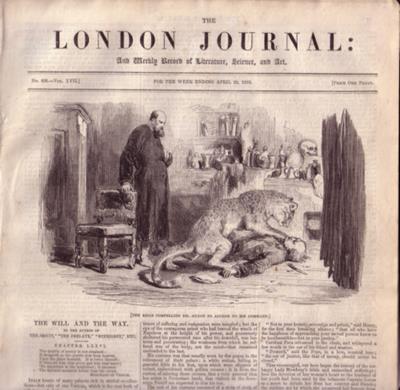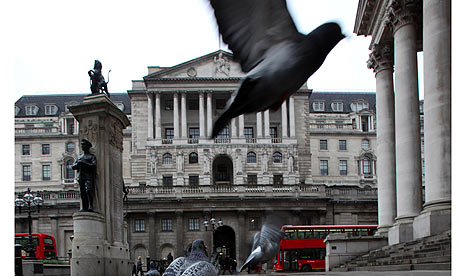Here is the first of an irregular series describing individual Victorian periodicals.
The title of the first is The Original. A lively, unillustrated 3d weekly 16-page miscellany (though its first issue comprised 12 pages and its last just 4), it ran 20 May 1835 – 2 December 1835 for 29 numbers, coming out every Wednesday for 3d and also monthly in a wrapper (its last number, the 4-page issue, cost only a penny). It was published by Henry Renshaw, 356 Strand, London and printed by Ibotson & Palmer, Savoy Street.
The Original was directed mainly towards the male upper middle classes “aloof from sect and party” (no.1 p.2), concerned, as its “Preliminary Address” states, with “whatever is most interesting and important in Religion and Politics, in Morals and Manners, and in our Habits and Customs”, leavened with anecdotes and autobiography, in an attempt to raise “the national tone in whatever concerns us socially or individually”.
It was written entirely by Thomas Walker, the son of a Manchester manufacturer and Whig reformer. Walker was born in 1784, gained his B.A. and M.A. from Trinity College, Cambridge, in 1808 and 1811 respectively, and was called to the bar in 1812. In 1829, he became a police magistrate in Lambeth court. Six years later, he began The Original for, he claimed, two reasons. Firstly, it would provide “a constant and interesting stimulus to my faculties of observation and reflection” – in other words, it would act as a kind of public diary – and secondly, it would provide for the reader “an alternative diet of sound and comfortable doctrines blended with innoxious amusement” (“Preliminary Address”). Walker was, however, unable to maintain a constant flow of new material and reprinted material from works he had already published, the most substantial of these being the pamphlet Suggestions for a Constitutional and Efficient Reform in Parochial Government (1834).
In social and political terms, the periodical criticises both Tories and Whigs in the interest of “Truth”, both being presented as oligarchic at bottom. True democracy, Walker opines, implies attrition of centralised government and devolution to the parish level where future men of state can be trained. Walker is staunchly against the Poor Law and indiscriminate charity of all sorts, positing bad morals on an individual level as the root of poverty in Britain, citing his experience of the courts as evidence. In this sense, it is a typical Whig/Radical miscellany of the 1830s.
The most famous and influential section of the miscellany in the nineteenth century and beyond was, however, “Aristology; or, The Art of Dining”. Beginning in number 13 and continuing until number 22, it received particular favour in the Quarterly Review. It was eventually published separately in 1883 with the rather unlikely suggestion it become a school textbook, edited by no less than Sir Henry Cole, founder of the Albert Hall, the Royal College of Music – and the National School of Cookery. It is possible to see the influence of Brillat-Savarin’s famous Physiologie du Goût (1825) in Walker’s mixture of charming anecdote and pseudo-science. However, recipes are conspicuously lacking: unlike Brillat-Savarin, Walker concentrated on refining the delights of consumption rather than production. His work relates to the gastronomic literature associated with gentlemen’s clubs such as George Vasey’s Illustrations of Eating (1847) and J. Timb’s Hints for the Table (1859) rather than to practical cookbooks such as Esther Copley’s Cottage Comforts (1825), Acton’s Modern Cookery (1845) or Beeton’s Household Management (1861).
To the media historian the most interesting parts of The Original comprise an irregular series of addresses to the reader in which Walker describes in detail his processes of composition in the tone of intimate letters to a friend. This ironic and stylish self-reflexivity is actually, as Walker explains, the result of the pressures of periodical publication: he can’t think of what else to write about except the problem of what to write. Typical of the romantic journalist, this, like the pieces on dining, is a variant of the “subjectified occasionalism” discussed by Carl Schmitt almost a century ago whereby “The romantic subject treats the world as an occasion and an opportunity for his romantic productivity” (Schmitt, p. 17). One may disagree with Schmitt’s condemnation that the author may “take any concrete point as a departure and stray into the infinite and incomprehensible – either in an emotionally fervent fashion or in a demonically vicious fashion, depending upon the individuality of the particular romantic” (p. 17) but the widespread attempt to capitalise on – even monetarise – individual bodily experience is certainly characteristic of the time. The political implications of such a valorisation will be one of the tributaries that feed into individualism (about whose elater development I have written elsewhere).
The last issue of The Original comprises mostly an “Address to the Reader” in which Walker begs leave to resume his periodical “the first Wednesday in March”, for “London living and authorship do not go well together”. He had become a celebrity: “My writings have latterly drawn upon me more numerous and cordial invitations than usual.” He was never able to fulfill this promise: after a short illness, he died in Brussels on 20 January the following year.
Useful Bibliographical References
Waterloo V: 3647 (NB information there erroneous)
editions 2-4, 1836, 1838, all published by H. Renshaw. I have not seen the 3rd edition. American editions were published certainly from 1837 e.g. by E.L. Carry & A. Hart in Philadelphia.
Walker, Thomas, The Original, 5th edition, edited and arranged under distinct heads, with additions by William A. Guy, M.B. Cantab, FRS, Renshaw, 1875
[Hayward, Abraham], review of The Original,Quarterly Review, February 1836 [Hayward, Abraham], The Art of Dining; or, Gastronomy and Gastronomes, Murray, 1852Schmitt, Carl, Politische Romantik, 1st edition 1919; 2nd and revised ed. 1925; trans. as Political Romanticism by Guy Oakes, MIT Press, 1986
[Walker, Thomas], Aristology, or The Art of Dining, with Preface and Notes by Felix Summerly (i.e. Sir Henry Cole), G. Bell & Sons: London, 1881 (subsequently, with “The Art of Attaining High Health”, ed. by Philip B. M. Allan, P. Allan & Co.1921; also with a Preface by Brooke Crutchley and illus. by Lynton Lamb, in a limited edition of 500 copies, CUP, 1965)“Walker, Thomas, 1784-1836” in the DNB.
Lynette Hunter, “Proliferating Publications: The Progress of Victorian Cookery Literature”, in Luncheon, Nuncheon and Other meals: Eating with the Victorians, ed. C. Anne Wilson, Alan Sutton, 1994, 51-70.





![[Picture: Edward Bulwer, (Lord Lytton.)]](http://www.fromoldbooks.org/WorldsBestMusic/pages/067-Edward-Bulwer-Lord-Lytton/067-Edward-Bulwer-Lord-Lytton-q75-378x500.jpg)

